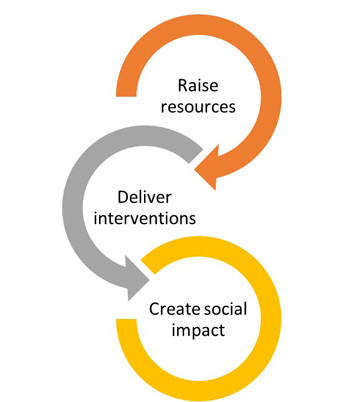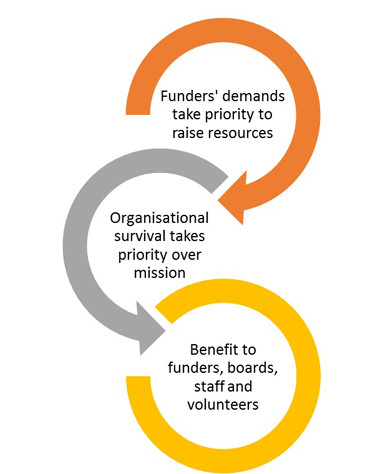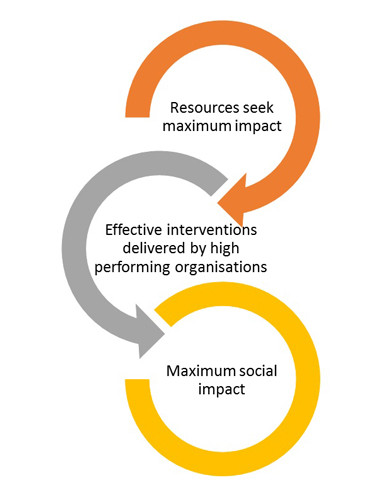When Thomas Kuhn wrote the Structure of Scientific Revolutions, he couldn’t have imagined how far his work would reach beyond the field of history of science. In fact he played a major role in bringing the term “paradigm” into widespread modern usage, to describe an accepted set of theories, assumptions, and practices that together constitute the “normal” view of the world. He described how periods of normal science were disrupted by revolutions, during which there would be a discontinuous transition to a new paradigm—a new normal.
I believe that the social sector needs to undergo just such a paradigm shift.
That the nonprofit sector has changed hugely in recent years is beyond dispute. It has grown, become increasingly professionalized, and over the last decade started coming to grips with planning and measuring its impact. Yet these are incremental changes, and I believe that the sector’s trajectory does not point to a pivotal future role in solving social problems and delivering social justice.
Moving toward more effective organizations
 Conceptual model of a fundraising nonprofit. (All images courtesy of NPC, 2014)
Conceptual model of a fundraising nonprofit. (All images courtesy of NPC, 2014)
A simple conceptual model of a fundraising nonprofit is made up of two main cycles: raising resources and delivering interventions. This nonprofit creates social impact if it delivers effective interventions, which it can do only if it has first raised the resources it needs to fuel its work. It maximises its social impact if it is a high-performing organization, delivering effective interventions.
Are you enjoying this article? Read more like this, plus SSIR's full archive of content, when you subscribe.
There is a growing focus on what nonprofits individually, and the sector as a whole, need to do to ensure that they are high-performing and effective. I am proud to work for NPC, which has been at the heart of this movement in the UK for the last decade—a movement that appears to be gathering momentum in the United States.
So far, so good. If we live in a paradigm in which organizations are increasingly high-performing and effective, then shouldn’t we expect to see continuous improvement in the social sector? Wouldn’t we move en masse toward more effective interventions and slowly maximize the sector’s social impact?
But for this to work, we also need both halves for the nonprofit paradigm—raising the resources and delivering interventions—to follow suit. We need more effective, high-performing organizations to raise resources more readily than less impact-focused peers. At the moment, I would argue that our attention is too focused on the latter half.
Is funding moving toward impact?
In the UK and United States alike, evidence and experience show that funders on the whole are still too focused on their own particular priorities to seek out the most effective solutions (see, for example, NPC reports on nonprofits’ reporting to grant funders, nonprofits’ impact practice, motivations and behaviors of individual donors, and research by the Center for Effective Philanthropy on foundations’ views of their own impact). There are of course exceptions, such as the Edna McConnell Clark Foundation and recent strategic programs of the Big Lottery Fund in the UK, but most funding practice is still overwhelmingly funder-centric. Take a few examples:
 If impact isn't central to the model—an “anti-social sector.”
If impact isn't central to the model—an “anti-social sector.”
The focus among donors on minimizing overhead costs: good for a donor who cares about not wasting their money, not so good for a nonprofit seeking to invest in anything that might lead to greater future effectiveness.
The lack of strategic collaboration between institutional funders: good for funders who want to know what their distinct contribution is, not so good for building coordinated action toward shared goals.
The focus in reporting by nonprofits not on learning and improvement, but on meeting funders’ requirements and compliance: good for funders who want to ensure that they haven’t made “bad” grants, not so good for anyone extracting any learning at all from the millions of dollars and pounds thrown at evaluations that sit on dusty shelves.
Overall, there is a lack of meaningful accountability among funders to those they claim to help.
The result of this funder-centricity at its worst is that the social sector exists not for those it’s supposed to help, but in fact for those who work in it, volunteer in it, and give money to it. An anti-social sector if you will.
This is an intentionally extreme interpretation, but if we look at behaviors and practices that we would expect of an imaginary anti-social sector and then find that our sector abounds with them in real life, we should perhaps revisit our asssumptions about who we are here to serve and whether we are doing well enough.
What might a new paradigm look like, and could we ever get there?
 Maximizing impact.
Maximizing impact.
If we are genuinely to focus on what we need to maximize social impact, we have to start with the beneficiary, not the funder. That means understanding the lives of beneficiaries through research, experience, intuition, and every tool we have at our disposal. It also means understanding the system in which they exist, and through which we will deliver and mediate any and all interventions.
A very brief outline of a systems thinking approach to maximizing social impact would include:
- Identifying a social issue;
- Defining and mapping the system collaboratively;
- Engaging stakeholders from all sectors;
- Reviewing evidence from academia and practice;
- Developing shared theories of change and measurement frameworks;
- Delivering shared goals through pooled resources or clear, complementary roles;
- Developing infrastructure for data capture, analysis, and sharing at appropriate levels;
- Scaling social impact through scaling organizations, interventions, value chains, or practices;
- Embedding learning and continuous improvement at a system rather than an organizational level;
- Collecting evidence, analyzing, synthesizing, and sharing at a field level; and
- Iterating.
Collective impact approaches are, of course, a critical element of this new paradigm. But they can emerge only once there is a commitment to taking a systemic approach—it is not clear that they can exist sustainably within the old paradigm, in which organizations still primarily compete for funding to survive.
There are a number of elements of this new paradigm that NPC is currently exploring, which I will share in more detail in a future article. They include: data labs, an innovative model of intermediating between government outcomes data and nonprofits that need it; systemic approaches to scaling, including research and action exploring the myths of scaling, and what it takes to scale impact within a system and with a fundamentally multi-sector approach; and shared measurement and collective impact, developing shared frameworks that become the standard across a whole field.
But a grave question still overshadows these new strategies—exciting as they are. They are all technical solutions—supply side solutions to the problem of how to maximize impact. They presuppose that there is a demand to maximize impact—to take the systemic view. Through programs like Inspiring Impact, we are starting to work on stimulating demand, as is Mario Morino and the movement he is starting to build in the United States.
Are we ready to embrace the new normal?
Ultimately, our collective success will rest on whether there is an appetite in the social sector, among its leaders and supporters, to embrace a paradigm shift. As an idealist and optimist, I believe that none of us wants the social sector to bear any resemblance to the anti-social sector I have outlined.
These issues are bubbling up more in the consciousness of the social sector, specifically within the field of philanthropy. In recent debates between Bill Schambra and Paul Brest about “strategic” philanthropy, the issue of the power dynamic between funder and funded has come to the fore. Ultimately, power should rest with neither party, but with those beneficiaries they seek to help. In my view, the only way to do this is to put a systemic view first.
Time will tell whether the social sector really has the leadership it needs to put its own interests after those it is here to serve.
Support SSIR’s coverage of cross-sector solutions to global challenges.
Help us further the reach of innovative ideas. Donate today.
Read more stories by Tris Lumley.

